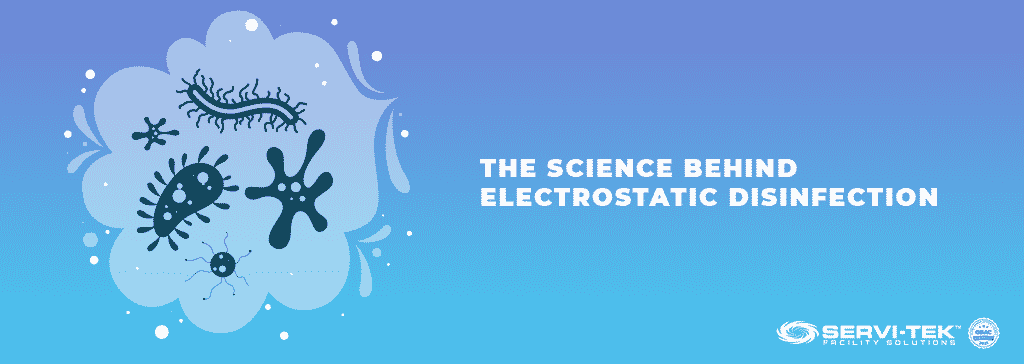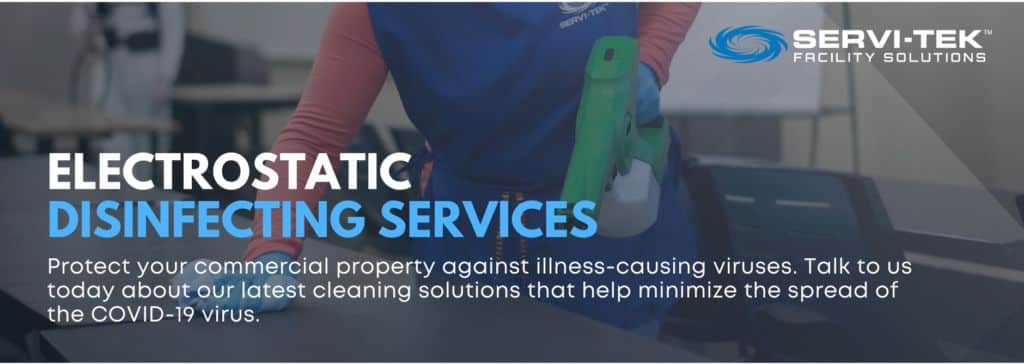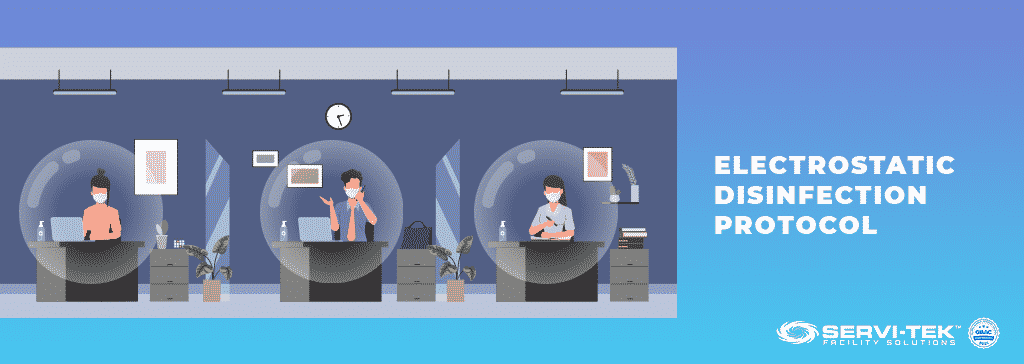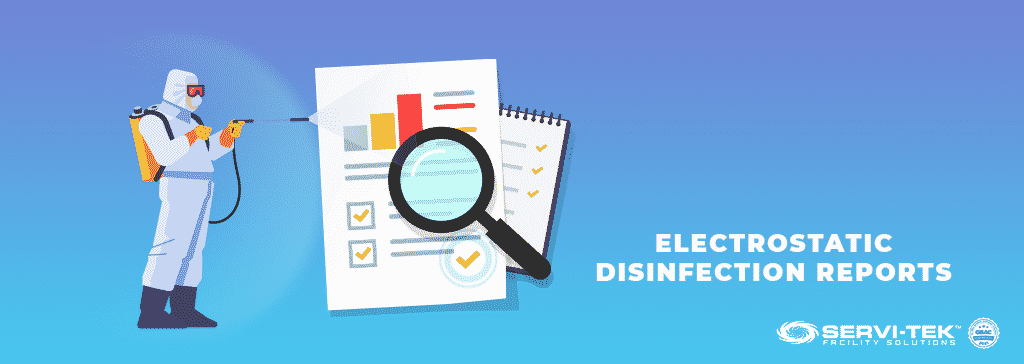
COVID-19 is the latest illness that the Centers for Disease Control and Prevention has issued guidelines about. In the past, the CDC has dealt with influenza, HIV, MRSA, and many other germs, and bacteria.
Electrostatic disinfection is a relatively new advancement in commercial and industrial cleaning. It is one of the best ways to protect your facility against the constant threat of pathogens.
You may be familiar with this technology, but have you taken the time to properly grasp how it works and what makes it so popular?
What Is Electrostatic Disinfection?
Electrostatic disinfection services are increasingly popular in medical facilities, office settings, and industrial environments for all types of surfaces.
They can be used as an alternative to manual cleaning and disinfecting or as an add-on that complements other cleaning technologies.
With an electrostatic sprayer and a single solution tank, you can disinfect large areas in no time.
Another significant advantage is that because the droplets are electrically charged, they actively seek for surfaces to adhere to and wrap around all edges of an object.
This makes disinfecting a chair at a hospital or an office desk a simple task that takes only seconds.
How Does Electrostatic Disinfection Work?

Electrostatic spray disinfection uses an electrode to atomize and create a positive electrical charge.
The positive electrical charge is attracted to negative surfaces, sticks to them, and leaves no residue on the covered surfaces after drying.
How does it work?
More specifically, a disinfectant solution is placed in the device’s reservoir, which is connected to a spraying nozzle. It then disperses the droplets of a solution to reach any surface or object that may be infected.
The disinfection involving vapor, mist, or fogging must be performed by properly trained professionals, due to the risks associated.
EPA approves that electrostatic application is effective for cleaning and disinfecting large high-touch areas quickly.
The Science Behind Electrostatic Disinfection

Disinfection is always critical when an indoor area was occupied by someone suspected of having COVID-19.
The CDC encourages a variety of strategies for cleaning and disinfecting institutions, businesses, and other public indoor areas.
Cleaning surfaces with a soap or detergent is recommended before disinfecting them to remove any materials that may be obstructive.
Electrostatic spraying technology has been used in a variety of other applications and industries over many decades. Industries that have embraced this technology include those operating in the realms of agriculture and automotive work.
Some of the most practical uses related to the Coronavirus include classrooms, lobbies, waiting areas, gyms, cafeterias, and more.
The ability to fully cover surfaces evenly and slowly dry without having to be wiped are critical benefits.
Many facility managers have chosen electrostatic technology throughout most industries and environments.
Why Was This Method Appropriate for This Pandemic?
The COVID-19 pandemic created a need for disinfecting all types of areas, particularly spaces with large numbers of people. Settings that are most susceptible to spread include being close to others who are:
- Breathing heavily and more likely to disperse breath droplets from activity such as exercising or cheering;
- Anytime when large groups are together for an extended time, such as 20 minutes or more;
- When some type of equipment is being shared including items on store shelves, lockers, or gym equipment;
- Areas with high-touch surfaces including handrails, elevator buttons, table tops, vending machines, and coffee stations;
Here’s why electrostatic disinfection is one of the best methods to keep viruses at bay in any commercial or industrial space:
Method 1: Electrostatic Disinfection Cleans the Surfaces of Items Touched by the Infected Person
SARS-CoV-2 is commonly transmitted between individuals with exposure to the same surfaces that have not been cleaned and disinfected.
Electrostatic disinfection works effectively on surfaces in most indoor settings by killing the virus.
A great advantage of the method is that already covered surfaces repel the spray, which reduces the likelihood of overuse, lowers the costs, and boosts efficiency.
The virus has proven to be vulnerable to various detergents, solvents including alcohol and hydrogen peroxide, bleach, and peroxyacetic acid.
According to the National Collaborating Centre for Environmental Health, electrostatic spraying is roughly 29 times better at covering surfaces compared to traditional methods.
Method 2: Electrostatic Disinfection Cleans Infected Clothing
Although COVID-19 is not transmitted through the pores of the skin, protective clothing is often worn in medical facilities.
You can get in contact with contaminated clothing and then touch your face, allowing the virus to reach the nose, mouth, or eyes.
CDC guidelines state that laundry items such as clothing, blankets, and towels should be washed using hot water.
Clothing suspected to be infected should be handled only by someone wearing gloves and a mask. Rather than disinfecting clothes, many facilities choose to simply wear disposable garments; however, this might not always be feasible.
When necessary, the application of a decontaminant by electrostatic dispersal is a great option for full disinfection.
How Successful Is Electrostatic Disinfection?
There is a lot of research already available on the topic of electrostatic disinfection.
In summary, using an electrostatic sprayer to apply a disinfectant enables fast and effective disinfection of portable equipment and broad open spaces.
This method is also proven to effectively limit the overuse of chemicals and has lessened the tedious process of manually cleaning sensitive environments such as hospitals.

What Is the Best Way to Electrostatic Disinfect?
Electrostatic disinfection is an option usually reserved for use after-hours, as it is impractical while the indoor areas are occupied. The electrostatic unit should use exclusively disinfectants that have been approved by the EPA for surface applications.
Medical environments are potential breeding grounds for harmful bacteria and viruses that could create dangerous results for vulnerable patients.
The method has been used extensively in institutional environments with high-risk occupants such as in hospitals, nursing homes, and surgery centers.
Some of the key metrics used in electrostatic disinfection include the rate of dispersal of the disinfectant and spraying distance. Measuring the coverage area is challenging, but involves variables including the charge/mass ratios and adherence of the liquid to surfaces.
Some of the most detailed analysis and testing recently has involved assessing the effectiveness of sodium hypochlorite solution on the coronavirus.
Feedback has been very positive, particularly in decontaminating vast spaces such as lobbies, gyms, and airports.
The application must always be directed at objects and target surfaces—not simply sprayed into the air. The operator should adhere to some uniform path for application: for example clockwise or counterclockwise.
Many experts recommend applying the disinfection in zones beginning from the opposite area of the door and working back. The disinfectant should be sprayed in a reasonably slow motion starting from the top and working down.
The operator should consult with the manufacturer’s recommendations regarding the distance between the applicator and the target. Generally speaking, the surfaces being sprayed should be wet but not overly saturated and dripping or pooling.
The CDC highlights the importance of contact or “dwell time” to achieve the maximum level of disinfection.
This is the time that the disinfectant should remain wet on the target surface to ensure full effectiveness against germs.
Electrostatic Disinfection Offers a Cost-Effective Approach

Several factors may impact the cost-effectiveness of electrostatic disinfection when compared to traditional methods of application.
One source of potential savings stems from using less disinfectant solution—which may vary based on product selection.
The efficiency in terms of application is time-based, which may translate to quantifiable savings in terms of labor costs. For example, an hourly wage worker may accomplish the same goal in fewer hours.
To measure cost-effectiveness, we must also consider the cost of having a commercial cleaning company perform electrostatic disinfection.
The alternative would be purchasing the equipment and supplies needed for performing this type of disinfection using in-house staff members.
Electrostatic sprayers are categorized into two general types based on whether the sprayer is handheld or backpack-style.
Battery-power handheld sprayers on the low-end have a minimum cost of roughly $600; however, can reach nearly $1,000.
The backpack-style units are more suitable for large commercial applications and kits often range from $1,500 to $2,000. The backpack models are now capable of disinfecting 20,000 square feet or more of space on a single fill of solution.
The costs can be too much for a business, and besides covering the equipment, as a building manager, you must also hire and regularly train professionals.
Even with the best technology, if the machine is not used correctly, the results will fail to meet expectations and your facility will become a pathogen spreading ground.
Electrostatic Disinfection Protocol

There are many best practices for improving the overall effectiveness of disinfection as well as those associated with safety. The COVID-19 pandemic has spurred awareness regarding the importance of maintaining improved indoor air quality in structures with many occupants.
Having sufficient airflow and ventilation are fundamental to reducing the level of indoor air pollution, much of which is undetectable.
Large workplace environments, particularly industrial settings, often generate very obvious air pollution that needs ventilation.
In many cases, the airborne contaminants are much less apparent and the building’s ventilation system might not be prioritized. When using spraying applications such as electrostatic tools, the need for reasonable ventilation is more apparent.
Electrostatic disinfection is often performed while a building or a particular area is not occupied. After the application, the space should remain closed off for several hours, with signage placed to discourage entry.
One key to efficiency and effectiveness in electrostatic disinfection is removing obstructions that prevent the disinfectant from contacting the surfaces.
For example, successfully disinfecting a workstation’s desktop is unlikely when objects or paperwork are scattered across it.
Surface disinfection is also significantly hindered by failing to clean before beginning the disinfection process. Similarly, to how an object placed on the surface prevents disinfection, dirt and grime create the same effect.
Building occupants should be encouraged to declutter their workspaces before leaving to help the disinfection process. The provider of electrostatic disinfection services will likely have responsibility for cleaning surfaces with soap and water before beginning the application.
The disinfectant used must be one contained in the EPA’s approved list for both safety and efficacy.
List N is subject to ongoing revision as the EPA further explores the best options for use in electrostatic applications.
Other critical best practices include using adequate personal protective equipment (PPE) and adhering to product instructions.
Following an electrostatic application, the equipment is typically cleaned by draining the solution and running water or a rinsing agent through.
Electrostatic Disinfection Supplies
Another means of categorizing electrostatic spraying systems is based on the source of power—either A/C or battery.
A/C sprayers plug into an outlet, which delivers benefits including consistent and reliable power and air compressor capability.
Adding an air compressor has been shown to allow for more uniformity by dispersal of “evenly sized droplets.” Meanwhile, the battery-powered units offer increased mobility without the need to accommodate an A/C cord.
The battery-powered units have traditionally struggled with performance and consistency stemming from an insufficient flow of power. In recent years, the lithium batteries used in many models have improved, yet still are susceptible to average performance.
In many cases, a secondary battery supply is charged and waiting to replace a depleted existing unit. A/C models also include a system ground, which is important and is built into the charging outlet.
One of the most useful types of supplies or accessories is a cart that is used for easier movement of backpack-style systems. Many of these models are on wheels and can easily navigate through doors.
Electrostatic Disinfection Maintenance
Electrostatic disinfection systems require surprisingly little maintenance, as they have only a few components. The primary maintenance task, which is critical for ongoing performance, is property removing the chemical disinfectant by flushing with water.
Flushing out the existing agent from the reservoir and lines is particularly critical when switching to a different chemical. Here, water is typically flushed through the unit completely for 20 seconds to ensure that no residual chemical remains.
The chemical tank should be disconnected from the device for storage or long transport to prevent unexpected spills, etc. Like the machines used for painting large areas, failing to property rinse or flush the system after use can create a nozzle clog.
Once clogged, the nozzle generally must be submerged in hot water with some detergent and then manually flushed using compressed air. The majority of these devices are sold with a replacement warranty of one year.
Electrostatic Disinfection Reports

While the EPA regulates the disinfectants and sanitizers used, the sprayer systems themselves are not. This means that no standard methods for testing these devices exist; therefore, the manufacturer’s specifications are critical.
In recent years, the EPA has implemented efficacy requirements for manufacturers, which are dependent on in-house testing.
One of the most common performance tests involves swab testing a surface that has been disinfected to detect any microorganisms.
The EPA’s Office of Research and Development provided partial funding for a study edited with help from the University of Manitoba. The report evaluated six various sprayer models and was posted by the Public Library of Science (PLOS ONE).
Some of the reported findings included:
- Most devices averaged droplet sizes of VMD of ≥ 40 microns;
- Four of the units produced a positive charge and two carried a negative charge;
- The “wrap-around” effect of the sprayers was largely disappointing when tested on a cylinder-type object;
- Losses of the chemical disinfectants were minimal and concentration levels on sprayed objects were consistent.
Electrostatic Disinfection Sources
There are many manufacturers of these devices that are sold through both big box retailers and distributor networks.
For commercial applications, working with a distributor helps choose a system that adequately meets the needs of a facility.
History Of Electrostatic Disinfection
The technology has existed for more than 60 years, predominately in the agriculture and automotive industries. In recent years, the technology was adopted for the application of agents used in cleaning, disinfection, and sanitizing.
The method of application has proven successful in efficiency, cost-effectiveness, and many other advantages.
Now, as technology evolved, excellent solutions are used in facilities that replace traditional cleaning methods, sanitation tactics, and disinfection services.
Electrostatic Disinfection Vs. Standard Methods
The most common disinfection procedure is to wipe a surface with a rag after the cleaning solution has been administered. While this method is widely used, it has several drawbacks.
When wiping down surfaces with a rag, bacteria can be transferred from one surface to another.
Furthermore, many people are unaware that disinfection solutions are required to stay on the surface for a certain amount of time before being washed away, which varies depending on the chemicals used.
There’s no need to worry about wiping surfaces too quickly or transmitting bacteria with electrostatic disinfection. Furthermore, the method ensures that the entire surface is covered.
Electrostatic Disinfection Vs. UV Disinfection
Ultraviolet (UV) lighting is a technology used for sterilizing objects in healthcare settings. The primary drawback is that UV can only be used in enclosed areas without any occupants because of health risks.
UV-C lighting technology is also used effectively as a supplemental measure for air treatment in building duct systems. UV-C lighting does work to eradicate airborne viruses from the air and ventilation systems.
Electrostatic Disinfection Reduces Pathogens
Facility professionals are encouraged to consider using EPA-approved disinfectants applied by electrostatic sprayers.
The disinfectant used should have proven effective in tests by qualified engineers and be noted on the labeling.
Challenges With Reducing Pathogens on Surfaces
Electrostatic disinfection systems are inherently subject to possible human error. For example, the user might lack knowledge regarding the settings for optimizing the nozzles.
Another challenge involves disinfecting surfaces that cannot hold a charge. For example, electrostatic technology often relies upon creating positively charged particles that adhere to a negatively charged surface.
Also, if the surface is dirty, or is hindered by other objects, then the bacteria will not be fully eliminated and multiply again.
It is important to work with a commercial cleaning contractor that is GBAC (Global Biorisk Advisory Council) certified. This is the cleaning industry’s only accreditation for outbreak response and recovery. It demonstrates that the contractor has correct work practices, procedures, and systems in place for preparing, responding, and recovering from outbreaks and pandemics.
Leading Provider of Commercial Cleaning and Electrostatic Disinfection Services
Servi-Tek Facility Solutions is a leading provider of commercial cleaning and maintenance solutions for large business environments. Electrostatic disinfection services are merely one of the comprehensive offerings that are available for our clients.
Our team will ensure that high-touch surfaces are properly cleaned and disinfected according to CDC guidelines.
We now use cleaning solutions that are Biosafety Level 3 rated in addition to certified antibacterial options to maintain safety.
Don’t wait and contact us for a free consultation, advice, and support in making the best choice for your facility!




